Run, Squid, Run
By Capt. Thomas J. Rapone
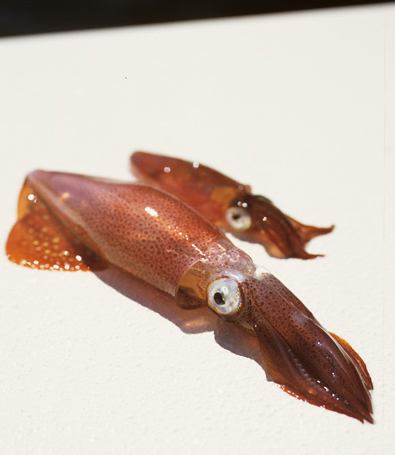
Home | Saltwater Flies | Fly Tying Materials | Saltwater Fly Fishing Accessories
Ordering Instructions, Shipping rates, Your Satisfaction Guaranteed | Site Map

|
For those of you who are not familiar with New England, Martha's Vineyard is an island off the coast of Massachusetts with excellent saltwater fly rodding, and a community of saltwater fly anglers that are some of the most experienced and progressive in this part of the world. When conditions are right, the waters around Martha's Vineyard are host to a fantastic event each year - the spring Squid Run! Vineyard angler and Charter captain Tom Rapone was kind enough to share the excitement of the Squid run on Martha's Vineyard with us, so tie on a squid fly or a great big popper, and hold on to the rail... Spring means romance on the rips of Martha's Vineyard for spawning squid, that is. And like moths to the flame of cephalopod passion, you can always count on striped bass to crash this yearly reunion with the most intense, ink-spraying, topwater action of the season. It's no secret that stripers love squid. A huge range of ocean predators from swordfish and seabass, to laughing gulls and lady crabs, and just about any sea creature that can fly, swim, or crawl its way to a delicious squid dinner will do so at every opportunity. Many anglers are surprised, however, to see the amazing lengths that a hungry striped bass will go to in order to get a squid in its mouth. When the Vineyard squid run is at its peak, generally sometime between Memorial Day and the last week of June, the topwater show can rival that of any false albacore blitz. Thoughts of half-pound adult squid leapfrogging across the surface with a pack of 40-inch bass in desperate airborne pursuit keep Vineyard anglers turning out piles of squid-flavored poppers and streamers during the long, dark North Atlantic winters. As anyone who has witnessed the Vineyard squid run firsthand can attest, the old-time striper nickname "squidhound" has nothing to do with the fish's sense of smell. The scene for this squid rodeo can be any one of hundreds of underwater sandbars, or "rips" that crisscross the waters of Vineyard Sound and the adjoining Atlantic. When these bars are found in area of strong current, the harsh upwelling created by the clash of tide and bottom structure at these sites create ideal ambush points for hungry migrating bass on the prowl for an early-season meal. From late May until the first week of July, the slightest change in bottom topography can be a potential bass hot spot. 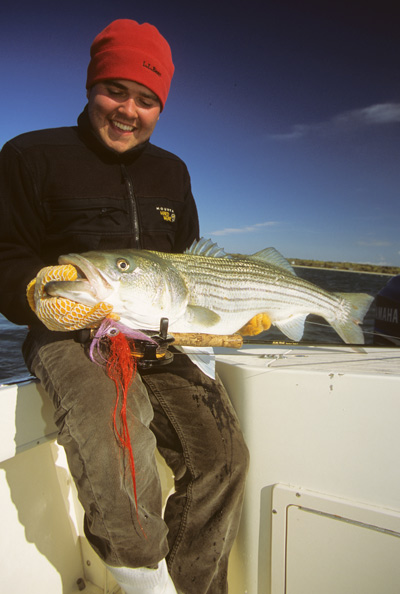
Spawn, Squid, Spawn Jump, Squid, Jump Of course, you can't always count on fish-in-a-barrel conditions. On days with weak tides or lack of squid movement through the shoals, presentation can make all the difference. The main challenge anglers face in these situations is bass that are present in the rips (they almost always are when even the slightest hint of squid is on the tide) but are unwilling to come to the surface for a fly. This is where a deep presentation, often a relative term in skinny shoal water, will take stripers that seem glued to the bottom. But there are certain challenges involved in reaching ground level in fast current - even if it's only in four feet of water. In such cases, swinging squid patterns deep can save the day. 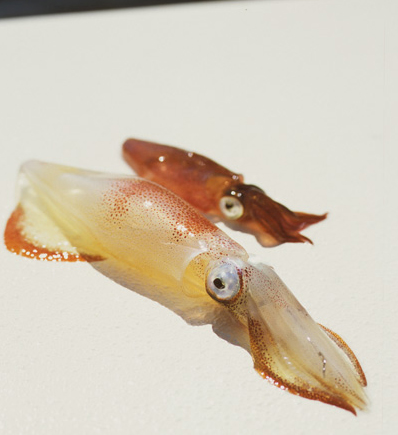
The preferred deep presentation often bears more resemblance to fast-water nymphing than the cast-and-blast popper fishing more often associated with surface squid blitzes. A typical scenario would go something like this: The captain positions the boat up-current from the rip line, bow into the current, while using the motor to stem the tide. An angler in the stern would then make a quartering cast with a sinking line towards the bow and out at roughly a 45-degree angle. The line and fly would then begin to swing back toward the rip line, sinking at the same time with the aid of two or three slack-line mends. When the fly is presumed to have reached the face of the rip (where most bass will be staked out, heads into the current), the angler would begin a fast-paced series of 1- to 2-foot, single-handed strips. Not only does this type of retrieve best imitate the panicked jet propulsion of a fleeing squid, it also enables anglers to quickly tighten up on any bow in the line that may have developed at this point in the swing. If all goes well, the heavy weight of a bass will help tighten things up on the other end of the fly line. Fly, Squid, Fly Prospective squid run anglers, however, should not be intimidated by the thought of tossing such large offerings. The combination of high-density sinking lines and well-designed patterns like Captain Jaime Boyle's Red Can Squid and Dave Skok's Mega Mushy Squid (both which incorporate all synthetic, water-shedding materials) make throwing the big squids a non-issue. And during the most intense squid carnage, casting is less an issue of grace and more one of simply getting the fly over the gunnels. 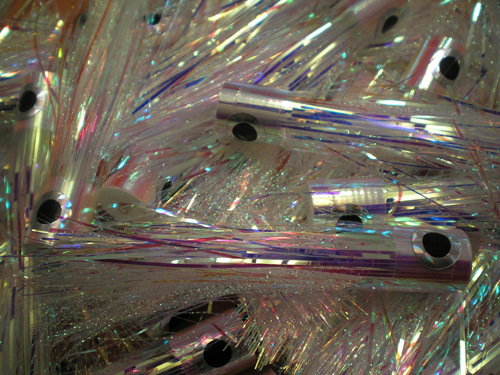
Strong currents, large flies, and the possibility of encountering truly trophy-sized bass make rip fishing a 10-weight affair. Short, 6- to 8-foot leaders aid in achieving depth when necessary, and bass holding in a 4-knot current rarely have the option of close inspection. Guides consider 20-pound tippet a must and most opt for a 30 to 50 pound mono shocker as insurance against the rasp-lipped cow bass that are almost always lurking when adult squid are about. This short piece of heavier leader can also provide just enough thickness to survive bluefish sneak attacks that are inevitable in any food-rich striper environment. As for fly lines, 350- or 400-grain sinking lines or shooting heads are standard for throwing large subsurface flies. Surface flies - any pattern that bobs or splashes has potential as long as it's on a high quality hook - are best presented with surface lines. Island guides will sometimes choose intermediates over floaters to cut through wave action in the rips as well as to anchor the buoyant flies in conditions of very fast-moving water. A Word of Caution As exciting as spring rip fishing can be, it's not for the faint of heart - nor is it for the inexperienced boater. Under the fishiest of conditions, the meeting of powerful tides and shallow sandbars often has anglers fishing into three or four-foot standing waves with the boat positioned in the relatively flat water on the up-current side of the rip. Add a touch of spring fog, and the scenario merits an "experts only" rating for boat handling. Nautical charts flag most shoal locations as "areas to be avoided". This is good advice for captains lacking experience in rip fishing. Proper local knowledge, a seaworthy hull, and a healthy respect for the powerful forces of nature at work in the rips are all prerequisites for attendance. Furthermore, even the most experienced rip fishermen spend a lot of time analyzing the effects of weather and tides on rip conditions and recommend that first-time squid run anglers seek an experienced hand at the helm. Wild conditions often lead to wild fishing, and for fly anglers riding the raging rips under a windswept sky, Vineyard's spring squid run is proof. For some of the best squid-fueled top water fishing around and a shot at giant early season stripers, hop a ferry to the waters of Martha's Vineyard this spring. 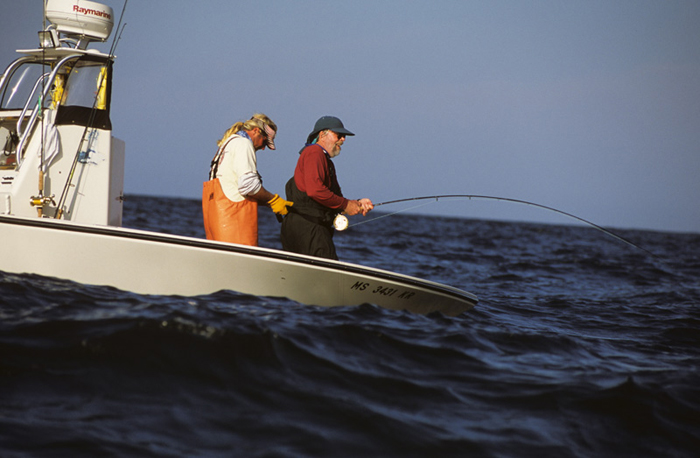
Captain Jaime Boyle helps an angler stay on board while fighting a big striped bass in the rips. Note: Saltwaterflies.com would like to thank Capt. Tom Rapone for this contribution
to our site. Though Tom's article focuses on his home waters of Martha's Vineyard, spawning
squid "runs" can be found in many other parts of the world as well, so be on the lookout
for other amazing opportunities like this that can be found in your part of the globe. Other hot spots for squid action in New England include the sand shoals south of
Cape Cod and Nantucket, which are part of the same geography as those near Martha's Vineyard,
as well as the reefs off of Rhode Island, and Long Island, New York. Want to learn more about striper fishing on Martha's Vineyard? The following websites can offer more information on fishing spots, timing, and techniques: 
Check out our other fly fishing and fly tying Articles and Stories. TIGHT LINES! SaltwaterFlies.com - Got Backing? |